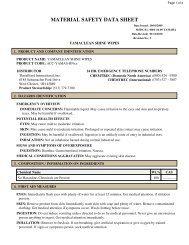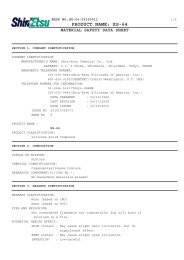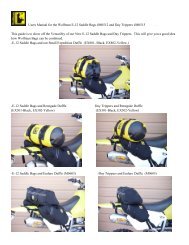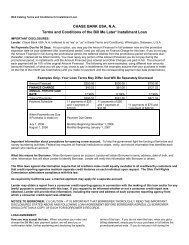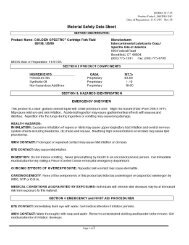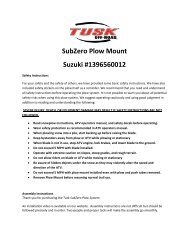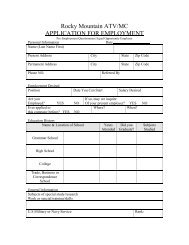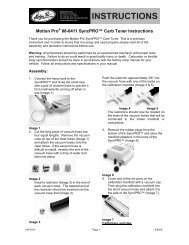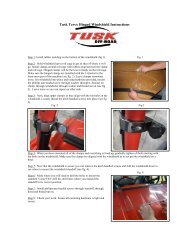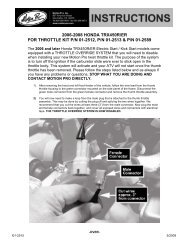MATERIAL SAFETY DATA SHEET - Rocky Mountain ATV/MC
MATERIAL SAFETY DATA SHEET - Rocky Mountain ATV/MC
MATERIAL SAFETY DATA SHEET - Rocky Mountain ATV/MC
Create successful ePaper yourself
Turn your PDF publications into a flip-book with our unique Google optimized e-Paper software.
Page 1 of 5<br />
<strong>MATERIAL</strong> <strong>SAFETY</strong> <strong>DATA</strong> <strong>SHEET</strong><br />
TB1401<br />
Date Issued: 02/25/2008<br />
MSDS No: 1403-04-02<br />
Date-Revised: 08/16/2010<br />
Revision No: 5<br />
1. PRODUCT AND COMPANY IDENTIFICATION<br />
PRODUCT NAME: TB1401<br />
PRODUCT DESCRIPTION: Agent for preventing screw loosening, leaking, and rusting.<br />
DISTRIBUTOR 24 HR. EMERGENCY TELEPHONE NUMBERS<br />
ThreeBond International, Inc.<br />
CHEMTREC (Domestic North America) :(800) 424 - 9300<br />
6184 Schumacher Park Drive<br />
CHEMTREC (International) :(703) 527 - 3887<br />
West Chester, OH 45069<br />
Product Stewardship: (513) 779-7300<br />
2. HAZARDS IDENTIFICATION<br />
EMERGENCY OVERVIEW<br />
IMMEDIATE CONCERNS: Flammable liquid and vapor. Causes eye irritation. Ingestion may be fatal or cause<br />
blindness.<br />
POTENTIAL HEALTH EFFECTS<br />
EYES: Causes eye irritation.<br />
SKIN: May cause skin irritation. Symptoms can include redness, burning, drying and cracking of skin, burns, or other<br />
skin damage.<br />
SKIN ABSORPTION: May be harmful if absorbed through the skin.<br />
INGESTION: May be harmful if swallowed. Ingestion is an unlikely route of entry in industrial uses.<br />
INHALATION: Harmful if inhaled. Material may be irritating to the mucous membranes and upper respiratory tract.<br />
SIGNS AND SYMPTOMS OF OVEREXPOSURE<br />
INGESTION: Methanol- Swallowing may be fatal or cause blindness. Effects due to ingestion may include nausea,<br />
headache, vomiting, gastrointestinal disturbance, dizziness, weakness, confusion, drowsiness, unconsciousness,<br />
convulsions.<br />
ACUTE TOXICITY: Methanol- Overexposure to methanol has been suggested to cause liver abnormalities and<br />
central nervous system damage in laboratory animals. Overexposure has been suggested to cause visual impairment in<br />
humans.<br />
REPRODUCTIVE TOXICITY<br />
REPRODUCTIVE EFFECTS: Methanol- has been found to cause birth defects in laboratory animals when inhaled<br />
at extremely high vapor concentrations. The relevance to humans is uncertain.<br />
MEDICAL CONDITIONS AGGRAVATED: Persons with the preexisting conditions of the following may be<br />
aggravated by exposure to this product: Skin. Lung. Liver. Kidney. Central nervous system. Pancreas. Heart.<br />
3. COMPOSITION / INFORMATION ON INGREDIENTS<br />
Chemical Name Wt.% CAS<br />
Methanol 65 - 75 67-56-1<br />
2-Propenoic acid, polymer with ethenyl acetate
Page 2 of 5<br />
contaminated clothing and shoes. Get medical attention immediately. Thoroughly wash or discard clothing and shoes<br />
before reuse.<br />
INGESTION: If swallowed, rinse mouth well with water if person is conscious. Do not induce vomiting unless directed<br />
to do so by medical personnel. Get medical attention immediately.<br />
INHALATION: Remove to fresh air. If not breathing, give artificial respiration or give oxygen by trained personnel. If<br />
signs or symptoms persist, seek medical attention.<br />
NOTES TO PHYSICIAN: This product contains methanol which can cause intoxication and CNS depression. Methanol<br />
is metabolized to formic acid and formaldehyde. These metabolites can cause metabolic acidosis, visual disturbances<br />
and blindness. Since metabolism is required for these toxic symptoms, their onset may be delayed from 6 to 30 hours<br />
following ingestion. Ethanol competes for the same metabolic pathway and has been used to prevent methanol<br />
metabolism. Ethanol administration is indicated in symptomatic patients or at blood methanol concentrations above 20<br />
ug/dl. Methanol is effectively removed by hemodialysis.<br />
5. FIRE FIGHTING MEASURES<br />
FLASHPOINT AND METHOD: 11°C (51.8°F) Closed Cup<br />
Notes: Lowest known value.<br />
AUTOIGNITION TEMPERATURE: > 200°C (392°F)<br />
FLAMMABLE CLASS: Flammable.<br />
EXTINGUISHING MEDIA: Use dry chemical powder, alcohol foam, or carbon dioxide.<br />
HAZARDOUS COMBUSTION PRODUCTS: Carbon oxides. May emit other toxic fumes under fire conditions.<br />
OTHER CONSIDERATIONS: Vapor may travel considerable distance to source of ignition and flash back.<br />
EXPLOSION HAZARDS: High temperatures or fire may cause container to explode. Use water spray to cool fire<br />
exposed containers.<br />
FIRE FIGHTING PROCEDURES: As in any fire, wear self-contained breathing apparatus pressure-demand,<br />
(MSHA/NIOSH approved or equivalent) and full protective gear.<br />
6. ACCIDENTAL RELEASE MEASURES<br />
SMALL SPILL: Eliminate all ignition sources. Absorb with an inert material and place in an appropriate waste disposal<br />
container.<br />
LARGE SPILL: Extinguish all sources of ignition. Stop spill or leak at source. Dike if necessary. Absorb with an inert<br />
material and place in an appropriate waste disposal container. Use non-sparking tools.<br />
RELEASE NOTES: Keep spilled material from entering storm drains, sewers, or other environmental mediums.<br />
COMMENTS: Disposal of clean-up materials may be governmentally regulated. Observe all applicable local, state, and<br />
federal waste management regulations.<br />
7. HANDLING AND STORAGE<br />
HANDLING: Avoid contact with eyes and skin. Wear appropriate personal protection. Wash thoroughly after handling.<br />
Empty containers may retain product residue and flammable vapors. Keep away from heat, sparks, and flame. Do not<br />
cut, puncture, or weld on or near the empty container.<br />
STORAGE: Keep container closed when not in use. Store in a cool, dry, well-ventilated area. Store and use away from<br />
heat, sparks, open flames, or other ignition sources.<br />
8. EXPOSURE CONTROLS / PERSONAL PROTECTION
Page 3 of 5<br />
EXPOSURE GUIDELINES<br />
OSHA HAZARDOUS COMPONENTS (29 CFR1910.1200)<br />
EXPOSURE LIMITS<br />
OSHA PEL<br />
ACGIH TLV<br />
Chemical Name ppm mg/m 3 ppm mg/m 3<br />
Methanol<br />
OSHA TABLE COMMENTS:<br />
1. S = Skin<br />
TWA 200 260<br />
200- S<br />
[1]<br />
262 [1]<br />
STEL NL NL 250- S 328<br />
ENGINEERING CONTROLS: Local exhaust ventilation may be necessary to control any air contaminants to within<br />
their TLVs during the use of this product.<br />
PERSONAL PROTECTIVE EQUIPMENT<br />
EYES AND FACE: Safety glasses. Wear splash goggles if the potential for splashing or spraying exist.<br />
SKIN: Gloves (impervious).<br />
RESPIRATORY: In case of insufficient ventilation, wear suitable respiratory equipment.<br />
PROTECTIVE CLOTHING: Chemically impervious clothing should be worn if potential for skin contact.<br />
WORK HYGIENIC PRACTICES: Wash hands before eating, smoking, or using restroom. Food or beverages should<br />
not be consumed anywhere this product is handled or stored. Wash thoroughly after handling.<br />
OTHER USE PRECAUTIONS: Facilities storing or utilizing this material should be equipped with an eyewash facility<br />
and a safety shower.<br />
9. PHYSICAL AND CHEMICAL PROPERTIES<br />
PHYSICAL STATE: Liquid<br />
ODOR: Methanol.<br />
APPEARANCE: Transparent.<br />
FLASHPOINT AND METHOD: 11°C (51.8°F) Closed Cup<br />
Notes: Lowest known value.<br />
SPECIFIC GRAVITY: 0.880<br />
VISCOSITY #1: 350 mPa. s<br />
(VOC): 70.000 %<br />
10. STABILITY AND REACTIVITY<br />
STABILITY: This product is stable under normal conditions.<br />
POLYMERIZATION: Product will not undergo polymerization.<br />
CONDITIONS TO AVOID: Sources of ignition. Heat.<br />
POSSIBILITY OF HAZARDOUS REACTIONS: Vapors may form explosive mixtures with air.<br />
HAZARDOUS DECOMPOSITION PRODUCTS: Carbon oxides. May emit other toxic fumes under fire conditions.<br />
INCOMPATIBLE <strong>MATERIAL</strong>S: Acids. Bases. Hypochlorites. Oxidizing agents. Reducing agents. Zinc.<br />
11. TOXICOLOGICAL INFORMATION<br />
CHRONIC: Methanol- Swallowing may be fatal or cause blindness. Effects due to ingestion may include nausea,<br />
headache, vomiting, gastrointestinal disturbance, dizziness, weakness, confusion, drowsiness, unconsciousness,<br />
convulsions.<br />
REPEATED DOSE EFFECTS: Methanol- Overexposure to methanol has been suggested to cause liver abnormalities<br />
and central nervous system damage in laboratory animals. Overexposure has been suggested to cause visual impairment<br />
in humans.
Page 4 of 5<br />
REPRODUCTIVE EFFECTS: Methanol has caused birth defects in laboratory animals, but only when inhaled at<br />
extremely high vapor concentrations. Relevance to humans is uncertain.<br />
12. ECOLOGICAL INFORMATION<br />
COMMENTS: Not Available<br />
13. DISPOSAL CONSIDERATIONS<br />
DISPOSAL METHOD: Waste must be disposed of in accordance with federal, state, and local environmental control<br />
regulations. Consult your licensed waste contractor for detailed recommendations.<br />
14. TRANSPORT INFORMATION<br />
DOT (DEPARTMENT OF TRANSPORTATION)<br />
PROPER SHIPPING NAME: Flammable Liquid, N.O.S.<br />
TECHNICAL NAME: Methanol Solution<br />
PRIMARY HAZARD CLASS/DIVISION: 3<br />
UN/NA NUMBER: UN1993<br />
PACKING GROUP: II<br />
AIR (ICAO/IATA)<br />
SHIPPING NAME: Flammable Liquid, N.O.S.<br />
TECHNICAL NAME: Contains methanol<br />
UN/NA NUMBER: UN1993<br />
PRIMARY HAZARD CLASS/DIVISION: 3<br />
PACKING GROUP: II<br />
15. REGULATORY INFORMATION<br />
UNITED STATES<br />
SARA TITLE III (SUPERFUND AMENDMENTS AND REAUTHORIZATION ACT)<br />
FIRE: Yes ACUTE: Yes CHRONIC: Yes<br />
EPCRA SECTION 313 SUPPLIER NOTIFICATION<br />
Chemical Name Wt.% CAS<br />
Methanol 65 - 75 67-56-1<br />
CERCLA (COMPREHENSIVE RESPONSE, COMPENSATION, AND LIABILITY ACT)<br />
Chemical Name<br />
Wt.% CERCLA<br />
RQ<br />
Methanol 65 - 75 5000 lbs.<br />
TSCA (TOXIC SUBSTANCE CONTROL ACT)<br />
TSCA STATUS: There are no ingredients in this product that are listed on the TSCA 12B list.<br />
STATES WITH SPECIAL REQUIREMENTS<br />
Chemical Name<br />
Requirements<br />
Methanol<br />
CALIFORNIA PROPOSITION 65: No products were found.<br />
This product contains a component or components listed on the<br />
Massachusetts Right to Know list of hazardous substances.<br />
This product contains a component or components listed on the New<br />
Jersey Right to Know list of hazardous chemicals.<br />
This product contains a component or components listed on the<br />
Pennsylvania Right to Know list of hazardous substances.
Page 5 of 5<br />
16. OTHER INFORMATION<br />
INFORMATION CONTACT: (513) 779-7300, Regulatory Department<br />
REVISION SUMMARY: Revision #: 5. This MSDS replaces the August 16, 2010 MSDS. Any changes in information<br />
are as follows: In Section 14: DOT Proper Shipping Name, DOT UN/NA Number, DOT Secondary Hazard<br />
Class/Division<br />
HMIS RATING<br />
HEALTH: * 2<br />
FLAMMABILITY: 3<br />
PHYSICAL HAZARD: 1<br />
PERSONAL PROTECTION:<br />
NFPA CODES<br />
3<br />
2 1<br />
MANUFACTURER DISCLAIMER: To the best of our knowledge, the information contained herein is accurate.<br />
However, neither the above named supplier nor any of its subsidiaries assumes any liability whatsoever for the accuracy<br />
or completeness of the information contained herein. Final determination of suitability of any material is the sole<br />
responsibility of the user. All materials may present unknown hazards and should be used with caution. Although certain<br />
hazards are described herein, we cannot guarantee that these are the only hazards that exist.



